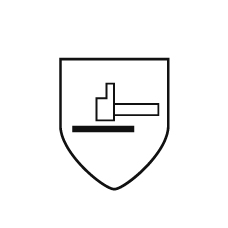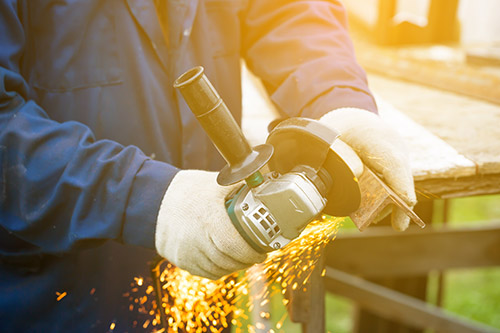| EN 388 Explained7 February 2018 If you've been looking for gloves that protect you from cuts and tears, you might have been confronted by unexplained gobbledegook on each and every website you visited. 'EN 388' and 'mechanical risks' are two of many such phrases we came across when we first started learning about gloves all those years ago. Before you fall down the rabbit hole of hyperlinks and become even more confused, take a look at our blog. We explain the European EN 388 standard in chunks that are easy to understand. So What Exactly is EN 388?EN 388 refers to a standardised way of testing the extent to which a glove is able to protect you against four different hazards (i.e. mechanical risks). These are:
If your handwear is deemed suitable for protecting you against these hazards, the following symbol will be proudly displayed on your gloves:
Under this badge, you're likely to see four numbers that show how protective your glove is in relation to the above four hazards. Generally, the higher the number, the better the performance and protection of the glove against mechanical risks. Find out how these are tested below. Abrasion ResistanceA sample of the glove is cut from the palm and rubbed against abrasive paper until it wears and a hole appears. This test is performed four times and the lowest value is chosen from the samples and used for classification. The number of rubs against the abrasive material correlate with one of four levels to gauge how resistant the glove is to abrasive forces.
Circular Blade Cut ResistanceSamples are again taken from the palm of the glove and placed on a machine. A circular, rotating blade is then moved backwards and forwards on the sample until it slices through the material of the test patch. The test patch with the lowest number of cycles is then compared to a standard reference material and the result is noted in the form of one of the five performance levels in the table below.
Tear ResistanceAs you might have guessed, four test patches from the glove are separately clamped between the jaws of a machine. These jaws then move apart until each sample tears. The smallest amount of force that it takes to rip the material will make up the level of resistance the glove is awarded.
Puncture ResistanceYou might be noticing a trend here! Again, four samples are taken from the glove. Using a compression test machine, a standard stylus is pushed 50mm into the patch at a speed of 100mm per minute. The lowest test result is then used to find the performance level of the glove.
Changes to the EN 388 TestAlthough a wide number of gloves still follow the EN 388: 2003 guidelines outlined above, the standard was revised in 2016 to add two new elements to the test. These are:
Straight Blade Cut Resistance
Like the cut resistance test using a circular blade, this test measures the cut resistance of a glove by drawing a blade across the sample until the blade breaks through the material. This new part of the EN 388 standard is only used if the blade used in the original cut test becomes so blunt that it is ineffective. Unlike the first cut-resistant test, this one won't blunt the blade as it only passes over the sample once before a new blade is used. This test also differs in terms of its result; instead of the usual numerical levels, the cut level of the glove is defined using letters from A to F. Level E roughly offers the same protection as a level five cut-resistant glove, while a level F shows that the glove provides an even higher resistance to cuts than previous EN 388: 2003 rankings.
Impact ProtectionThis test is optional and is used if manufacturers claim that a glove is resistant against impact. This tends to be on the back of the hand and/or on the knuckles. In this test, the glove sample is secured and impacted. Unlike the previous tests, this is a pass/fail test. If the glove passes the test, a 'P' will be shown on the glove marking. Reading the Mechanical Risk Glove MarkingAs PPE standards aren't applied retrospectively, the new 2016 guidelines will only affect new products that are being certified. As such, you'll probably still see a number of gloves with just four numbers beneath the EN 388 symbol. However, for new gloves you could see up to six numbers and letters. An example of this would be: 4 4 1 2 D P, which would correspond to the following results:
See How the EN 388 Standard is TestedAre you still curious about how the gloves are tested? If so, take a look at the video below to see how EN 388 is certified! We hope this has helped you decipher the likes of 'EN 388' and 'mechanical risks.' If you're interested in getting protection from mechanical risks, take a look at our range of EN 388 work gloves! | ||||||||||||||||||||||||||||||||||||||||||||||||||||||||||||||||||||||||||||||








